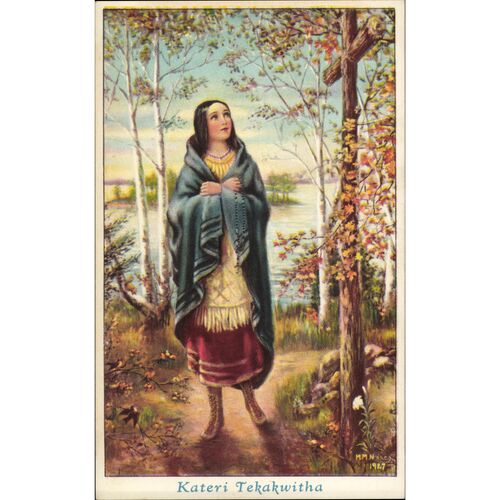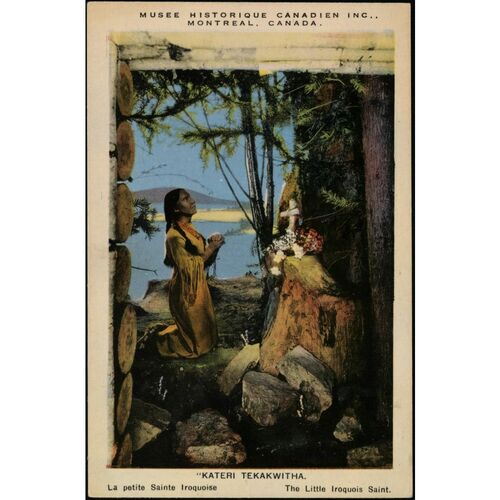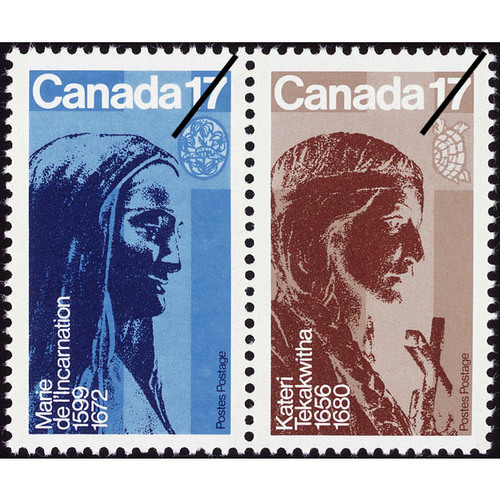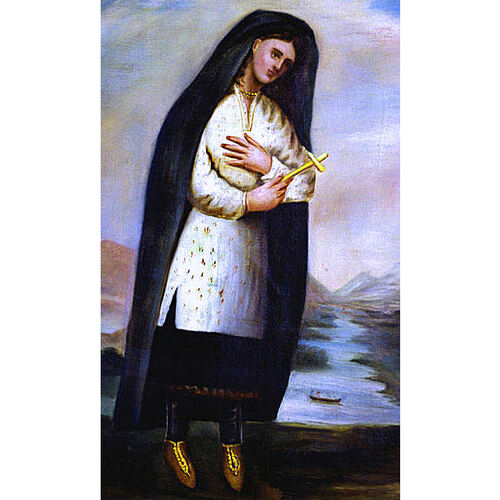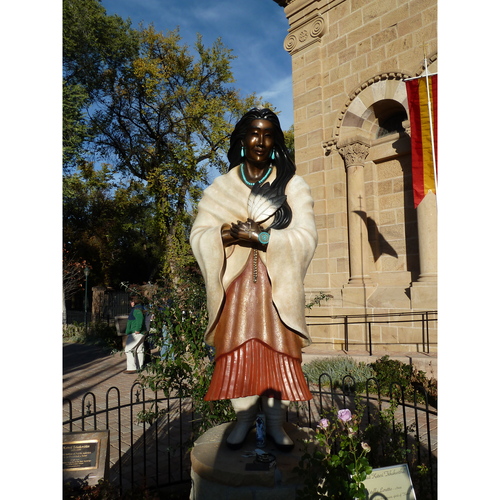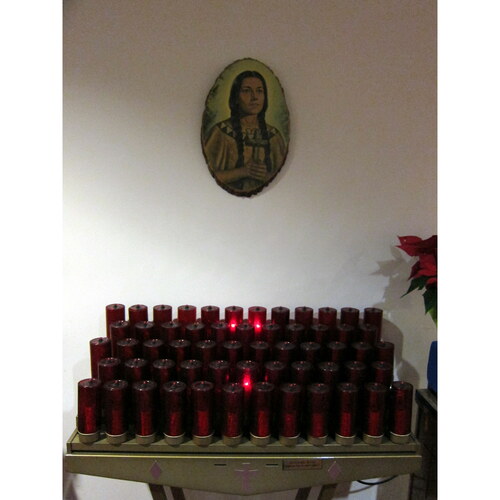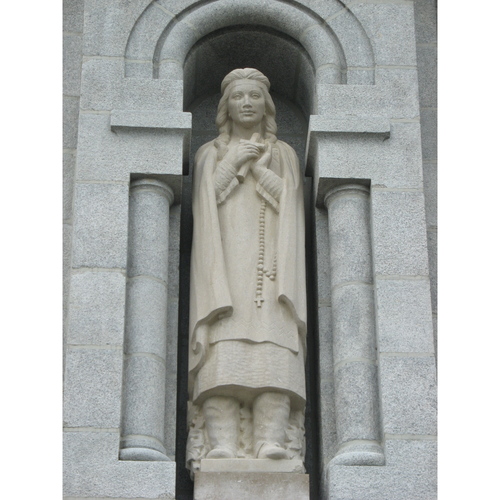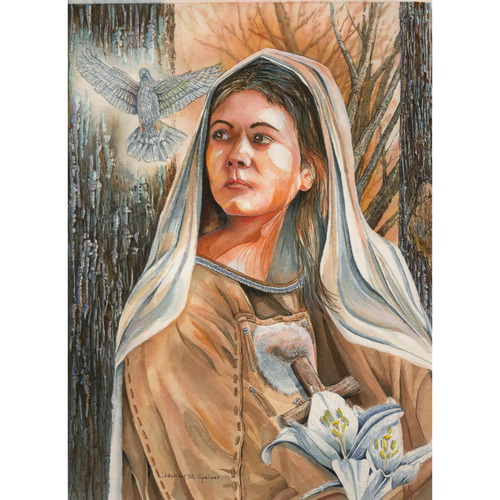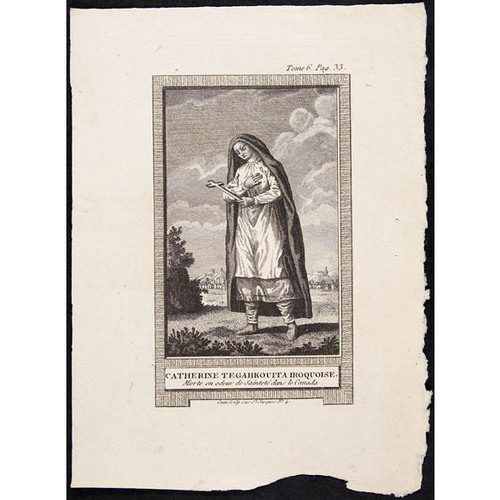TEKAKWITHA (Tekaouïta, Tagaskouïta, Tegakwitha), Kateri (baptized Catherine), the first North American indigenous person to be canonized by the Roman Catholic Church; b. 1656 at Ossernenon (Auriesville, N.Y.), daughter of an Algonkin and a Mohawk; d. 1680 near Montreal.
Tekakwitha’s Algonkin mother, a Christian who had been brought up by French settlers at Trois-Rivières, had been captured about 1653. Shortly afterwards she had been chosen by a Mohawk to be his wife. In 1660 she was carried off by smallpox, along with her husband and her last-born child. Young Tekakwitha, whose face was pock-marked and whose eyes were badly affected, almost died too. She was taken in by her uncle, the first chieftain of the village and a declared enemy of the Christian faith.
In the autumn of 1666 Prouville de Tracy came down from Quebec at the head of a punitive expedition and burned the centres of population of the Mohawk canton with all their stores. Ossernenon was rebuilt under the name of Gandaouagué, on the other side of the Mohawk River (Rivière des Hollandais), a little to the west of the former site. After this defeat the Mohawks begged for peace and asked for missionaries. They were sent Fathers Jacques Frémin, Jacques Bruyas*, and Jean Pierron, and the donnés Charles Boquet and François Poisson, who arrived at Gandaouagué in September 1667. During the three days that they stayed there, Tekakwitha had to take care of the Jesuits, whose piety and courteous manners impressed her.
On several occasions her relatives tried to make her marry, but she always refused, to their great displeasure. There is nothing surprising in this refusal, since two-thirds of the population of Gandaouagué was composed of Christian Algonkins and Hurons who had undoubtedly spoken to Tekakwitha about the Ursulines of Quebec and the religious life.
In 1675 Father Jacques de Lamberville*, a Jesuit, entered her lodge for the first time. She revealed to him her desire to receive baptism. The ceremony took place on Easter Day, 1676, and the young woman was given the name Catherine, which would be modified to Kateri.
Her conversion brought upon her a veritable persecution. She was even threatened with death. Amidst all these trials Father Lamberville advised her to pray unremittingly and to go to live at the Saint-Louis (Lachine) rapids. In the autumn of 1677, with the aid of three indigenous neophytes, she succeeded in fleeing.
It was at the Saint-François-Xavier mission that Kateri Tekakwitha definitely prepared herself for the Christian life. Anastasie Tegonhatsiongo, who had formerly been her mother’s friend at Ossernenon, acted as her spiritual guide. Because of her exceptional qualities she was allowed to take her first communion by Christmas of 1677, sooner than was usual for converts. In addition, in the spring of 1678 she was received into the Confrérie de la Sainte-Famille, despite her youth.
The strength of Kateri Tekakwitha’s spirituality lay in an extraordinary purity of body and soul and an efficacious charity towards all. This laywoman lived in full the life of her people, in the village as on the great winter hunts. Not until 1678, less than two years before her death, did she cease to accompany her people in their search for game; at this time the Eucharist had taken such a powerful hold upon her that, even at the risk of suffering hunger, she no longer wished to be away from the church for long months. Even in the fervent environment of the mission she had to endure great trials, in particular false accusations. Later her slanderers were the first to praise her.
Kateri Tekakwitha would have liked to found a community of indigenous nuns, but Father Lamberville persuaded her to give up the idea. On 25 March 1679, on the feast of the Annunciation, she was permitted to take in private the vow of perpetual chastity. It is easy to understand why posterity named her the Lily of the Mohawks.
She used to submit herself to painful mortifications, which she moderated on her director’s order. She concealed this penitential spirit to the best of her ability; she liked jokes and would laugh heartily.
Kateri, whose health had always been mediocre, became aware at the beginning of 1680 that she was seriously ill. On the Tuesday of Holy Week she received the last sacrament. The next day, 17 April, at barely 24 years of age, she passed away very easily while uttering the names of Jesus and Mary.
After her death Father Cholenec* observed that Kateri’s features, which had been marked by smallpox, had become remarkably beautiful. In consequence of conspicuous favours obtained through her intercession, there soon sprang up a strong devotion to her. In 1688 Bishop Saint-Vallier [La Croix*], the second bishop of Quebec, called her “the Geneviève of Canada,” a theme that Chateaubriand was to develop in Les Natchez. In 1744 Father Charlevoix* wrote that she was “universally regarded as the Protectress of Canada.” Kateri Tekakwitha was named venerable on 3 Jan. 1943 and then blessed on 22 June 1980, before being canonized on 21 Oct. 2012. Devotion to her has spread to Canada, the United States, and throughout the world. Each year pilgrims travel to Auriesville and to the Saint-François-Xavier mission at Caughnawaga, where her relics are preserved.
Since her death Kateri Tekakwitha has been the subject of numerous biographies in several languages.
Charlevoix, Histoire, I. Claude Chauchetière, La vie de la bienheureuse Catherine Tegakouita dite à présent la saincte sauvagesse (Manate, 1887). Pierre Cholenec, “Catherine Tegahkouita, la sainte sauvagesse,” BRH, XX (1914), 26–32, 61–64, 99–103, 134–36, 168; Catherine Tegahkouita, la sainte sauvagesse (Beauceville, 1914). JR (Thwaites). The Positio on Katharine Tekakwitha. Positio super virtutibus servae Dei Catherinae Tekakwitha.
Guy Boulizon, La croix chez les Indiens (Montréal, 1958). G.-C. Bouvier, Kateri Tekakwitha: La plus belle fleur épanouie au bord du Saint-Laurent (Montréal, 1939). E.-X. Evans, “The literature relative to Katheri Tekakwitha,” BRH, XLVI (1940), 193–209, 241–55. Édouard Lecompte, Une vièrge iroquoise, Catherine Tekakwitha: Le lis des bords de la Mohawk et du Saint-Laurent, 1656–1680 (Montréal, 1930). Robert Rumilly, Kateri Tekakwitha, le lys de la Mohawk, la fleur du Saint-Laurent (Paris, 1934). J. C. Steurer, The impact of Katharine Tekakwitha on American spiritual life (Washington, D.C., 1957). E. H. Walworth, Life and times of Kateri Tekakwitha (Albany, N.Y., 1926).
Revisions based on:
Arch. de l’Archidiocèse de Québec, “Sainte Kateri Tekakwitha”: archivesacrq.org/biographies/saints-et-bienheureux-du-canada/sainte-kateri-tekakwitha (consulted 9 March 2018). Canadian encyclopedia, “Saint Kateri (Kateri Tekakwitha)”: thecanadianencyclopedia.ca/en/article/tekakwitha-kateri (consulted 9 March 2018). The Holy See, “Homily of His Holiness Pope Benedict XVI, Sunday 21 Oct. 2012”: w2.vatican.va/content/benedict-xvi/en/homilies/2012/documents/hf_ben-xvi_hom_20121021_canonizzazioni.html (consulted 18 Sept. 2015).
Cite This Article
Henri Béchard, “TEKAKWITHA (Tekaouïta, Tagaskouïta, Tegakwitha), Kateri (baptized Catherine),” in Dictionary of Canadian Biography, vol. 1, University of Toronto/Université Laval, 2003–, accessed January 1, 2025, https://www.biographi.ca/en/bio/tekakwitha_1E.html.
The citation above shows the format for footnotes and endnotes according to the Chicago manual of style (16th edition). Information to be used in other citation formats:
| Permalink: | https://www.biographi.ca/en/bio/tekakwitha_1E.html |
| Author of Article: | Henri Béchard |
| Title of Article: | TEKAKWITHA (Tekaouïta, Tagaskouïta, Tegakwitha), Kateri (baptized Catherine) |
| Publication Name: | Dictionary of Canadian Biography, vol. 1 |
| Publisher: | University of Toronto/Université Laval |
| Year of publication: | 1966 |
| Year of revision: | 2018 |
| Access Date: | January 1, 2025 |


![Musee historique canadien Montreal, Canada, Kateri Tekakwitha, la petite sainte Iroquoise[sic] [image fixe] = Musee historique canadien inc., Montreal, Canada, Kateri Tekakwitha, the Little Iroquois Saint Original title: Musee historique canadien Montreal, Canada, Kateri Tekakwitha, la petite sainte Iroquoise[sic] [image fixe] = Musee historique canadien inc., Montreal, Canada, Kateri Tekakwitha, the Little Iroquois Saint](/bioimages/w600.1121.jpg)
